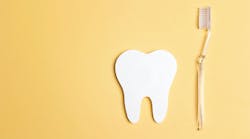How oral health influences brain health and stroke risk: Exploring the connection
As medical research delves deeper into the close relationship between oral health and systemic well-being, alarming findings emerge. Understanding this correlation underscores the importance of regular dental care not just in preserving our smiles, but also in preventing serious health conditions, including strokes.1
According to statistics from the World Stroke Organization (WSO), more than 13 million people suffer from strokes each year, and one in four people will have a stroke in their lifetime. Surprisingly, up to 90% of these cases could be prevented by making lifestyle changes such as adopting a healthier diet, increasing regular exercise, quitting smoking, and even improving regular oral hygiene.
Medical licentiate Olli Patrakka examined the significance of oral bacteria, especially viridans group streptococci, in the development of strokes in his recent doctoral dissertation in forensic medicine at the University of Tampere, Finland. Although these bacteria are normal mouth microbes, they can cause serious illnesses such as heart valve inflammation when they enter the bloodstream. For example, they can enter the bloodstream through inflamed gums while brushing teeth.2
Patrakka says, “These bacteria attach to the tooth’s surface in the mouth and initiate the process, leading to the formation of dental plaque. We hypothesize that a similar phenomenon occurs when bacteria that enter the bloodstream during, for example, dental procedures or dental infections travel into the walls of the arteries. This may accelerate the development of both strokes and atherosclerosis.”
Poor oral hygiene is a risk factor for strokes
According to Patrakka, dental bacteria can be found in the blood clots of stroke patients in about four out of five cases. A similar result has yet to be reported.
Blood clots from stroke patients treated in Tampere were collected for the study during acute care. In addition, samples from patients suffering from symptomatic carotid artery stenosis were used as tissues for endarterectomy.
Epidemiological studies have shown that poor oral hygiene is an independent risk factor for strokes. Patrakka says, “The results of my study suggest that the connection could be explicitly explained through the inflammatory reaction caused by dental bacteria in atherosclerotic plaques.”
New opportunities for treatment
The findings of the dissertation are significant as they open new opportunities to develop treatment for stroke patients. Patrakka estimates that the development of a vaccine may also be possible. So, what practical implications can these findings have on treating stroke patients and health-care practices? Although further research is needed to determine causality, the study supports the view that oral health must be taken care of, especially in those at risk of strokes.
According to Patrakka, the inflammation caused by streptococcal bacteria in the mouth should always be considered in stroke prevention as part of regular dental care. It is also essential to investigate the potential benefits of timely antimicrobial treatment or bacterial vaccines in the future.
Periodontitis is the root cause of many ailments
Studies show dental plaque bacteria are responsible for about 95% of oral diseases. One of the most common oral diseases is periodontitis, a severe gum disease caused by dental plaque. Early signs of this disease include red gums, gum bleeding, and bad breath.1
In patients with periodontitis, the fibers that attach the tooth to the gum are destroyed, forming a periodontal pocket between the gum and the tooth. This pocket may expand around the entire tooth. If the infection is not treated promptly and oral hygiene is not improved, it can progress to destroy more extensively the supporting tissues of the teeth and, ultimately, the jawbone.1
Thorough oral hygiene is crucial for the prevention and treatment of oral infections. According to the Finnish Institute for Health and Welfare (THL), more and more people in Finland brush their teeth at least twice a day, but there are still deficiencies in self-care. While about 80% of women brush their teeth at least twice a day, the corresponding figure for men is 53%.3 Deficiencies in oral hygiene are directly reflected in the statistics of oral infectious diseases. For example, gum diseases are worryingly common in the 30-44 age group, both in women (43%) and men (57%).
Thorough mechanical brushing of teeth and cleaning of the interdental spaces are crucial because even asymptomatic oral inflammations can affect the body’s overall health. According to statistics, individuals with healthy mouths live longer.
Every missing tooth reduces life expectancy. This is talked about far too little, says Tommi Pätilä, a heart and transplant surgeon at HUS New Children’s Hospital in Helsinki, Finland.4 Pätilä is also one of the developers of an antibacterial medical device (Lumoral, which is not yet available in the US) designed to improve oral hygiene and oral health. This method is especially suitable for patients with difficult-to-treat gum diseases such as periodontitis who do not get adequate results from traditional oral hygiene methods such as brushing teeth and cleaning interdental spaces.5-7
Interdisciplinary collaboration is key
Pätilä stresses that collaboration between doctors and dentists is essential and needs to be increased in Finland. Many doctors in Finland already check the oral health status of their patients at their clinics and guide them to further treatment as needed. Diabetes is an excellent example of a disease where the importance of hidden inflammations is generally understood. However, greater collaboration is needed to expedite many diagnoses and prevent general diseases. “The recent medical dissertation at the University of Tampere is significant as it addresses oral health as part of overall body health,” says Pätilä.
Olli Patrakka's interest in oral bacteria arose as part of his duties as a pathologist. When asked whether young doctors are becoming increasingly more interested in the impact of dental infections on general health, he responded, “It hasn't increased, but it should. In the basic medical training I received about five years ago, there was also no discussion of the impact of dental infections on general health. Of course, the topic is still relatively new, but hopefully, awareness and scientific evidence will gradually increase over the years.” He emphasizes that general practitioners should know when a dental problem requires referral to a dentist. This would expedite the treatment of oral infections and potentially support the achievement of balance in the treatment of many general diseases.
He concludes, “My research contributes to the evidence that the impact of oral health on general health is significant. The blood vessels of the tooth pulp are directly connected to the systemic circulation. Thus, bacteria and their metabolites can circulate directly into our bodies if the teeth are not in good condition.”
Editor’s note: This article first appeared in Clinical Insights newsletter, a publication of the Endeavor Business Media Dental Group. Read more articles and subscribe.
References
- Sen S, Giamberardino LD, Moss K, et al. Periodontal disease, regular dental care use, and incident ischemic stroke. Stroke. 2018;49(2):355-362. doi:10.1161/STROKEAHA.117.018990
- Patrakka Olli. Studies on the bacterial microbiome in thrombus aspirates of acute ischemic stroke patients. Dissertation presented to: the Faculty of Medicine and Health Technology of Tampere University; March 8, 2024; Finland. https://trepo.tuni.fi/bitstream/handle/10024/154588/978-952-03-3315-7.pdf
- The FinHealth 2017 follow-up study. Finnish Institute for Health and Welfare (THL). https://www.healthinformationportal.eu/health-information-sources/finhealth-2017-follow
- Koka S, Gupta A. Association between missing tooth count and mortality: a systematic review. J Prosthodont Res. 2018;62(2):134-151. doi:10.1016/j.jpor.2017.08.003
- Pakarinen S, Saarela RKT, Välimaa H, et al. Home-applied dual-light photodynamic therapy in the treatment of stable chronic periodontitis (HOPE-CP)—three-month interim results. Dent J (Basel). 2022;10(11):206. doi:10.3390/dj10110206
- Nikinmaa S, Alapulli H, Auvinen P, et al. Dual-light photodynamic therapy administered daily provides a sustained antibacterial effect on biofilm and prevents Streptococcus mutans adaptation. PLoS One. 2020;15(5):e0232775. doi:10.1371/journal.pone.0232775
- Nikinmaa S, Moilanen N, Sorsa T, et al. Indocyanine green-assisted and LED-light-activated antibacterial photodynamic therapy reduces dental plaque. Dent J (Basel). 2021;9(5):52. doi:10.3390/dj9050052
Nina Garlo-Melkas, MSc, is a health and science journalist who works as communications manager at Koite Health Ltd., a quickly growing health technology company and innovator in light-activated antibacterial solutions for treating and preventing oral diseases.
About the Author

Nina Garlo-Melkas, MSc
Nina Garlo-Melkas, MSc, is a health and science journalist.



